https://www.youtube.com/watch?v=KuVRaXdULWg
How to Draw a Fox (Red Fox)
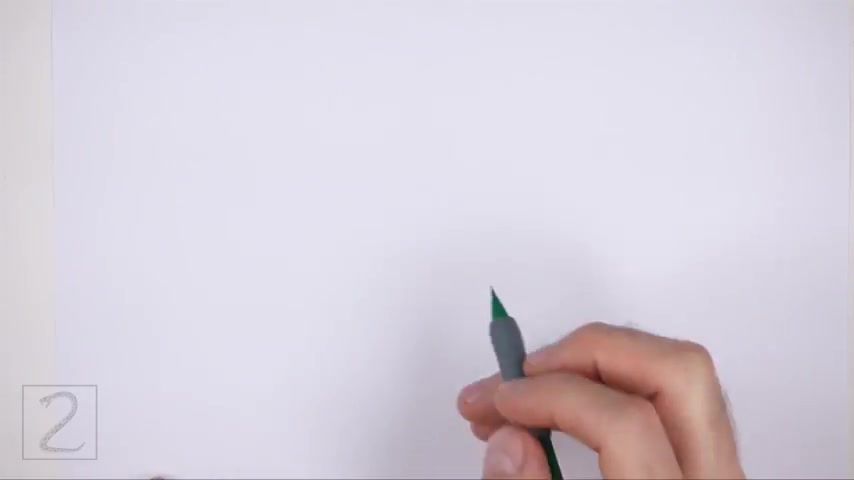
Hello , everyone .
In this video , we're going to draw Fox start by drawing a circle as a guide for the front part of the body to draw the circle .
First make two small marks to indicate the circle's length and then on the sides make two more small marks to indicate the circle's width .
Then connect the marks using curved lines to finish the shape of the circle .
The circle doesn't have to be perfect .
But if you're having trouble drawing it just trace the outer edge of a coin , a bottle cap or anything else with a circular edge to the right .
Draw another circle as a guide for the back portion of the body .
Use the four marks method to draw this circle too , draw the circle slightly smaller than the first circle .
Don't place the circles too far apart .
Otherwise the body will be too long , sketch lightly at first so that it's easy to erase if you make a mistake .
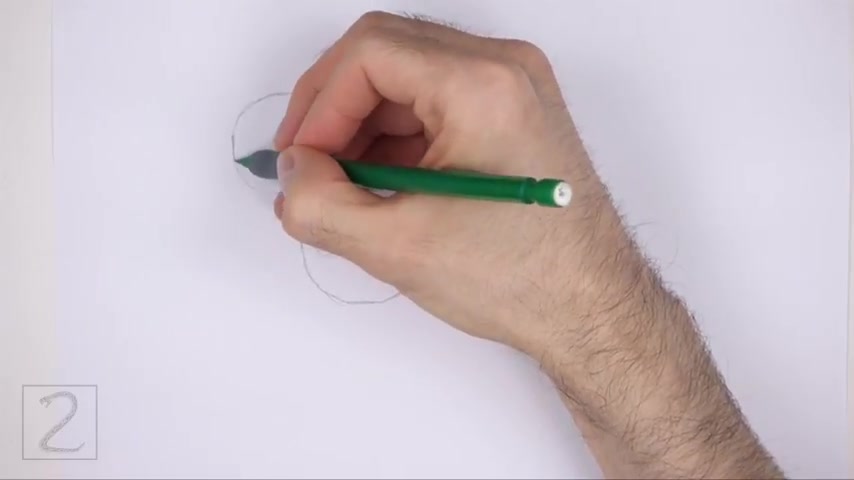
Also pause the video to draw at your own pace on the top left side , draw another circle as a guide for the head .
Use the four marks method to draw this circle as well .
First make four small marks to indicate the sides of the circle and then connect the marks using curved lines to finish the shape of the circle .
This circle should be about two thirds the size of the first circle inside the head draw a curved horizontal line .
This is a construction guide that will help you place the facial features later on on top of the horizontal line off to the left , draw a shorter vertical line .
For another construction guide under the horizontal line , draw a small circle as a guide for the muzzle , draw this circle slightly off to the left side , pay attention to the size of the circle in relation to the head .
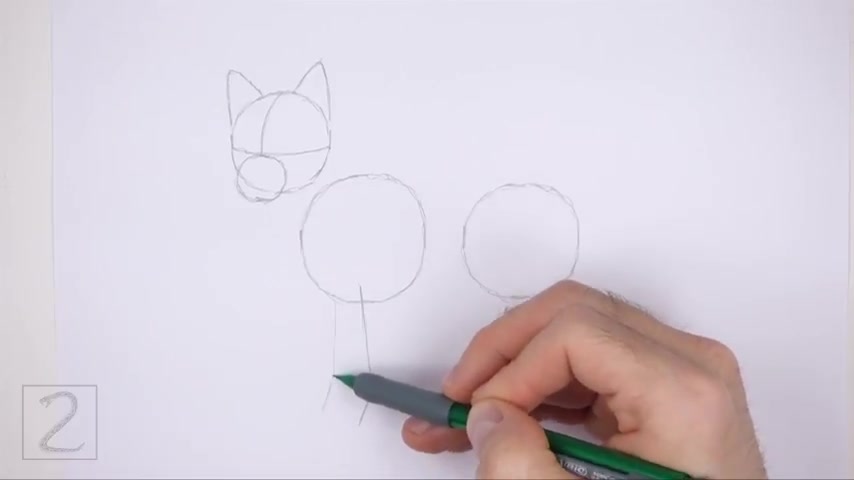
The bottom part of the circle should be below the edge of the head circle on top of the head , draw two triangular shapes as guides for the ears , foxes have big ears .
So don't make these shapes too small curve , the lines for the ears slightly outward below the body circle on the left , draw two long vertical lines .
As guides for the legs pay attention to the length of these lines in relation to the rest of the body .
The line on the left should be slightly shorter than the line on the right bend , the bottoms of the lines to indicate the joints under the circle on the right .
Draw two long lines as guides for the legs .
The first line should slope down into the right and then angle downward .
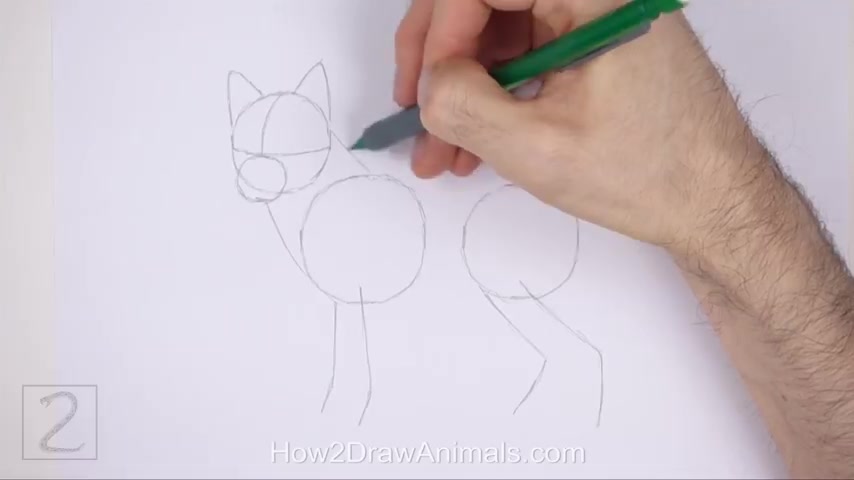
The line to the left should also slope to the right and then angle down but make it shorter , connect the head to the first circle using short lines to create the guide for the neck , connect the circles in the middle , using longer horizontal lines to finish the guide for the torso on the right side of the body , draw a long sloping line as a guide for the tail pay attention to the length of this line in relation to the rest of the body .
And that's it for the guidelines .
Now , let's start on the final drawing inside the head on top of the horizontal construction guide lightly sketch two small circles for the eyes place the circles on either side of the vertical construction guide pay attention to the size of the circles in relation to the rest of the head .
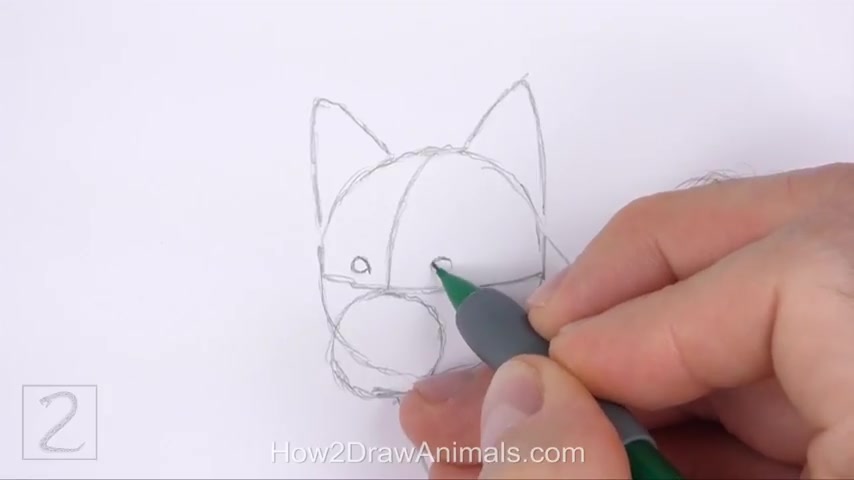
When you get the sides and position of the eyes , right darken the shapes short lines on the inner sides of the shapes for the inner corners of the eyes draw a couple of short angled lines on the outer edges of the shapes .
For the outer corners of the eyes , the inner corners of the eyes should point down toward the muzzle .
The eye on the left should be slightly smaller than the eye on the right because the head is slightly turned dark in the corners of the eyes inside each eye off to the side , draw a tiny circle for highlights in the middle of each eye , draw a thin shape for the cat like pupils .
You can also draw bigger circles in the middle and shade them in .
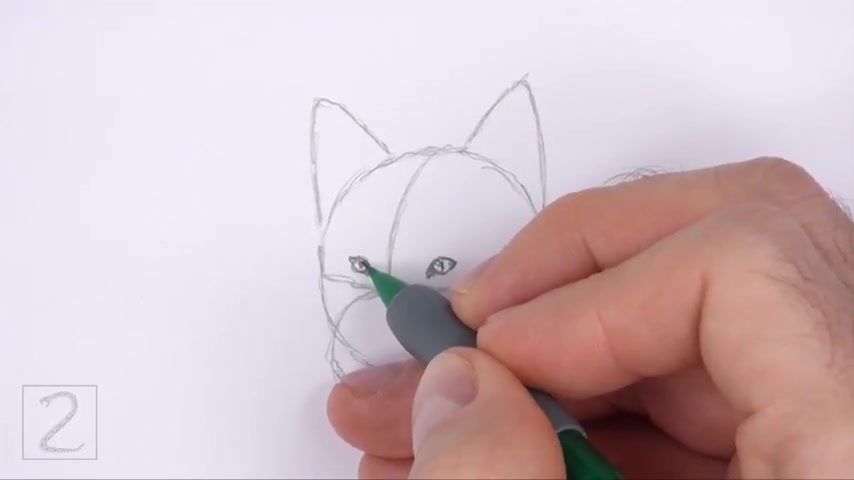
If you want the pupils to be dilated , add a bit of value to the top part of the eyes .
For a shadow , don't overlap the tiny highlight circles as you shade the eyes use a value that's lighter than the pupils .
When you shade the eyes had a few short strokes above each eye .
For fur darken the edges of the eyes and make the lines thicker inside the muzzle .
Close to the left edge , lightly sketch a small oval for the nose .
When you get the size and position of the nose , right darken , the shape draw a short thick line on the left side of the nose .
For the first nostril on the right side , draw a slightly longer angled line for the other nostril .
This line should be similar to a check mark .
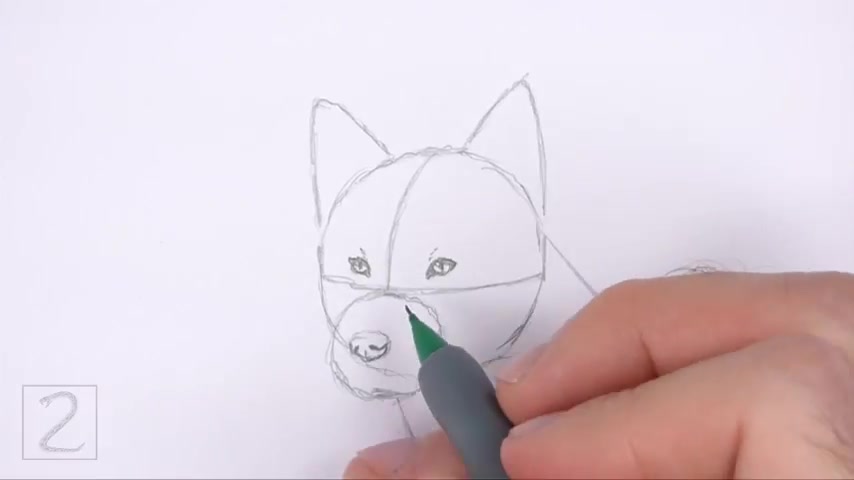
Add a short vertical line at the bottom of the nose darken the bottom edge of the nose , but make it a bit pointier .
A couple of short lines near the top part of the nose , use short strokes when you darken the top edge of the nose to represent fur below the nose , draw a horizontal line for the mouth on the left side curve , the line up along the edge of the initial circle for the side of the muzzle on the right side , extend the line farther to the right to make the mouth longer , make the line slope upward so that it ends on the edge of the initial circle , extend the left side of the line higher up for the bridge of the muzzle below the mouth , draw a short curved line that's made up of short strokes .
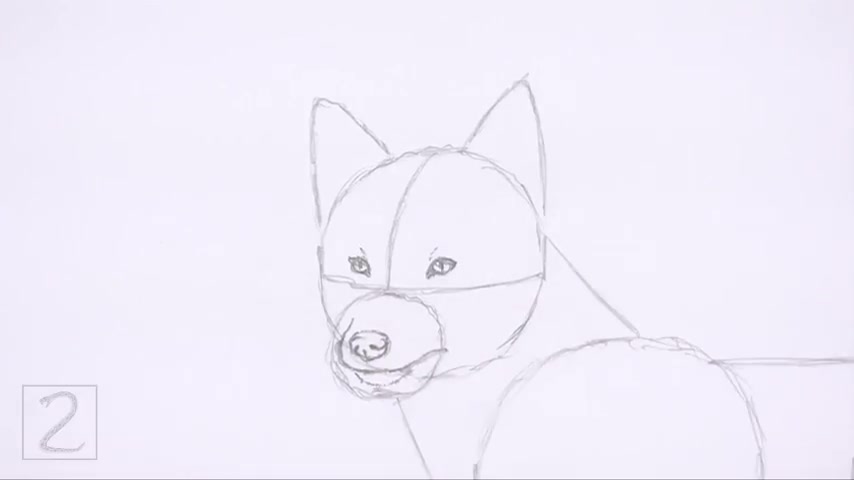
For the chin , use the triangular shape that's on the top right side of the head .
As a guide to draw the first ear darken , the shape would make the sides wavier and the top part rounder extend the lines farther down inside the head .
Inside the shape on the left side , draw a few short lines to give the ear more structure .
Now draw a series of short strokes within the shape for the fur that's inside the ear .
Use the triangular shape on the left side as a guide to draw the other ear the same way darken the shape but make the sides wavier inside , near the right edge , draw a curved line to give the ear more structure .
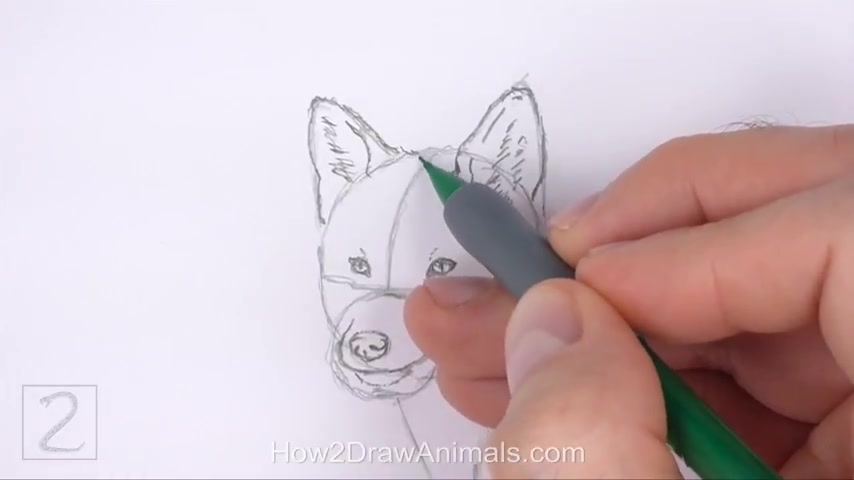
Add a few short strokes within the shape for the fur that's inside the ear .
Now use the big circle as a guide to draw the rest of the head , draw a series of short strokes along the basic path of the circle to create the shape of the furry head on the left side curve the line inward toward the eye to emphasize the structure of the head .
Add more short strokes below the ear on the right for the side of the head , make the bottom right side of the head slightly wider than the initial circle .
Add a few short strokes inside the head .
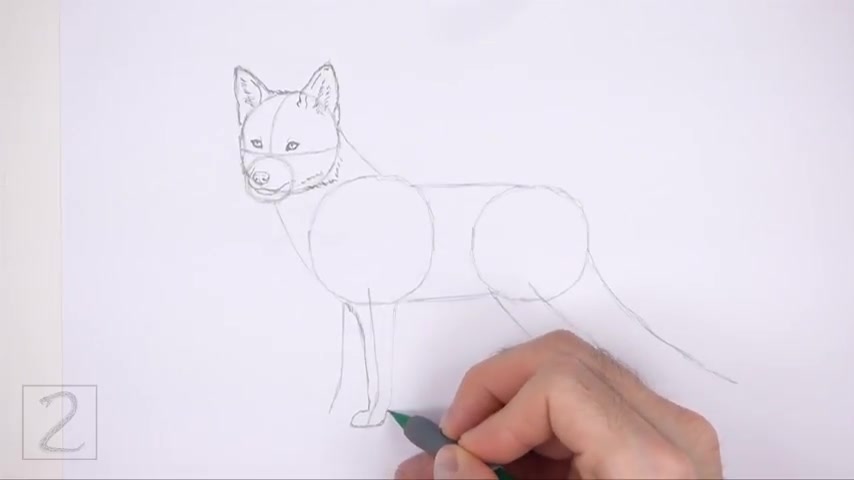
Now use the second line from the left that's under the body as a guide to draw the first front leg , lightly sketch the shape of the leg around the guideline , draw the top of the leg wide and then gradually make it thinner toward the bottom .
On the bottom , left side , draw a curved line for the paw .
When you get the shape of the leg right darken the lines , keep the edges of the leg close to the guidelines so that the shape is thin , use a few short strokes as you darken the leg for fur , draw two short lines on the tip of the pot to separate the toes .
Now use the line on the left as a guide to draw the other front leg the same way first lightly sketch the shape of the leg around the guideline , make the top part of the leg wider than the bottom curve .
The bottom part of the shape to the left to create the palm .
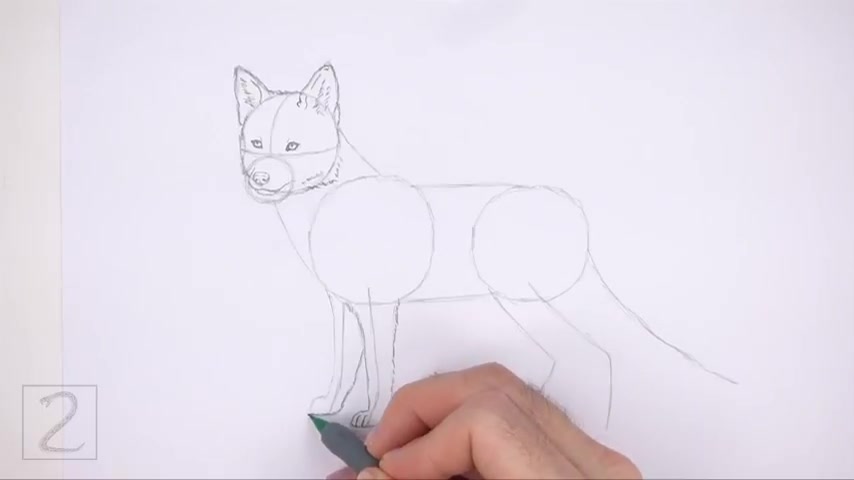
When you get the shape of the leg , right darken the lines , a portion of the top part of the leg will be hidden behind the first front leg at a short curved line inside the paw for the toes .
Now use the angled line on the far right side as a guide to draw the first hind leg just like before , first lightly sketch the shape of the leg around the guideline .
The top part of this leg should slope down into the right curve .
The middle part of the leg for the joint , the top part of the hind leg should be a lot wider than the top part of the front legs .
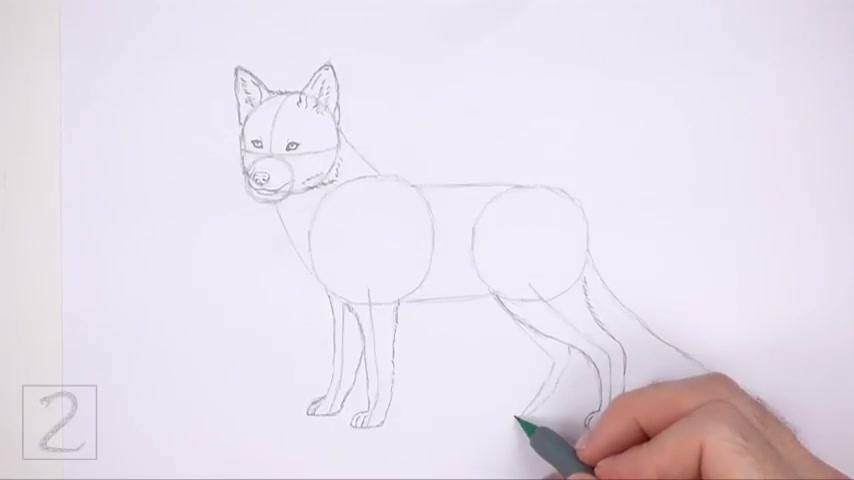
When you get the shape of the hind leg , right darken the lines inside the paw , draw two short curved lines to separate the toes dark in the top , right side of the leg using short strokes for fur , use the angled line on the left side as a guide to draw the other hind leg the same way , lightly sketch the leg around the guideline and only darken the lines .
When you get the shape right , make the top part of the leg wide and gradually make it thinner toward the bottom .
The top part of this leg will be hidden behind the first hind leg inside the paw .
Draw a short curved line for the toes curve the shape near the middle for the joint .
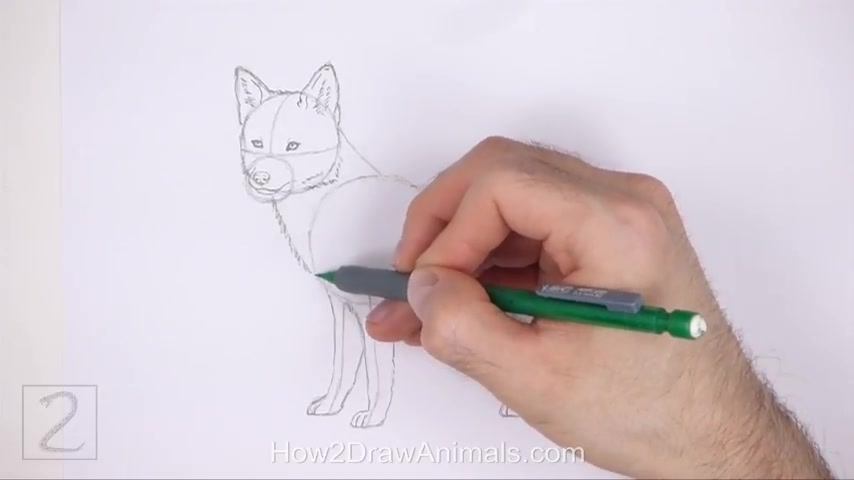
Now use the remaining shapes and lines as guides to draw the rest of the body simply darken the outer edges of the guides to create the shape of the body .
Use short strokes as you follow the path of the guides to create a furry texture .
Draw the big tail around the sloping line on the right side , make the shape of the tail wide , make the tip of the tail round and use short strokes to emphasize the fur .
Now erase the initial guidelines , the next few steps are sped up so that the video won't be too long .
Don't worry about erasing all of the guidelines .
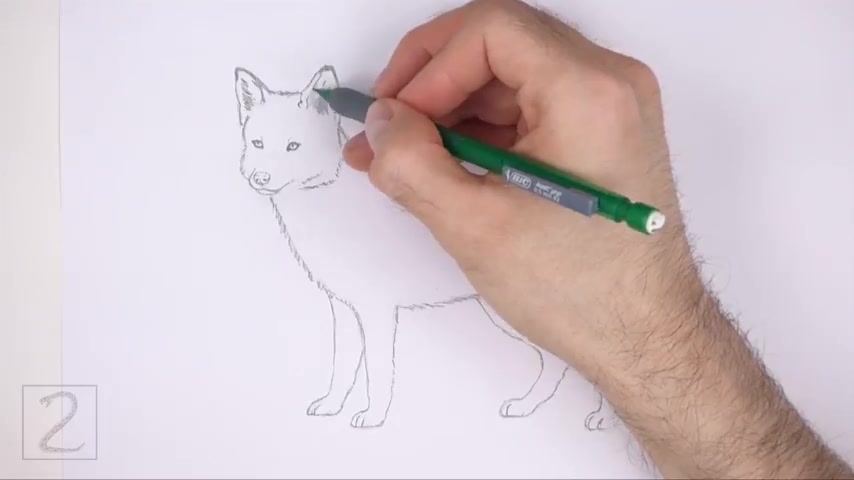
It's ok if you leave them behind , redraw any of the final lines that you may have accidentally erased and now shade your drawing , use a dark value for the nose , but leave a strip blank at the top for a highlight to the right of the nose .
Draw a few short lines for the base of the whiskers shade lightly at first and gradually build up to darker values for light values , push down very lightly on your pencil , then push down harder for darker values as you shade you strokes that go in the direction of the fur on the head .
The stroke should radiate outward from the nose on the body .
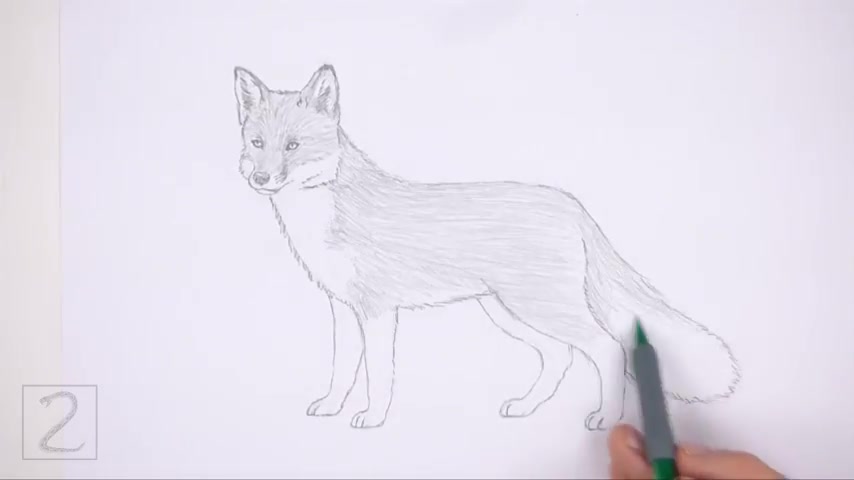
The stroke should be horizontal on the tail , they should slope down into the right and on the legs , the stroke should be vertical , the bottom part of the head , the underside of the body and the tip of the tail should be blank for the white fur slowly and gradually add more value throughout the body as you shade separate each stroke a bit so that the white of the paper comes through and creates a more furry texture .
Use a darker value on the legs for darker fur shading can be time consuming , so be patient and take breaks .
It's a good idea to use reference as you shade for a more accurate depiction of a fox , use a medium value on the white fur to create shadows , draw a shadow at the bottom using a medium value .
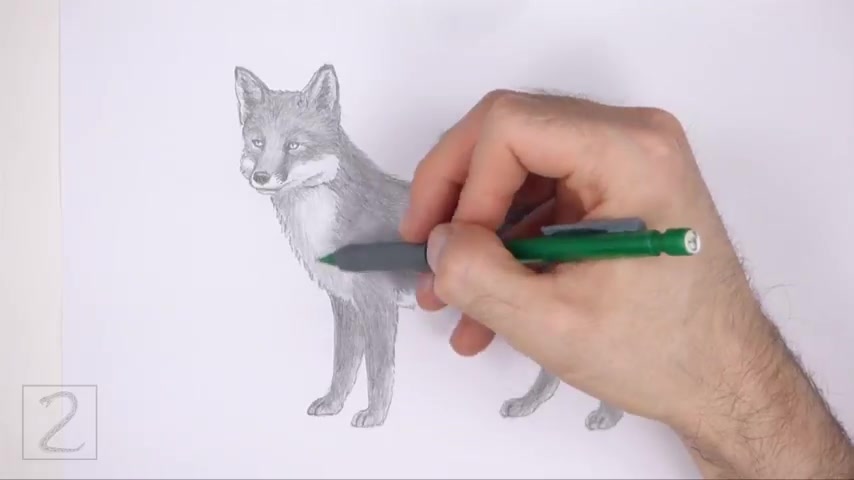
This grounds the fox so that it doesn't appear to be floating , keep shading until you're happy with the result .
And that's it for the fox .
Don't forget to pause the video to draw at your own pace .
Also , please visit how to draw animals dot com where every step of this tutorial is broken down into an individual image .
That's how and then the number two , then draw animals dot com .
If you enjoyed the video , please leave a like and a comment .
Also subscribe for more videos in the future .
Thank you for watching .
And until next time , keep drawing .
Are you looking for a way to reach a wider audience and get more views on your videos?
Our innovative video to text transcribing service can help you do just that.
We provide accurate transcriptions of your videos along with visual content that will help you attract new viewers and keep them engaged. Plus, our data analytics and ad campaign tools can help you monetize your content and maximize your revenue.
Let's partner up and take your video content to the next level!
Contact us today to learn more.